'Modell Bauhaus'
Scritto da Architonic
Svizzera
18.08.09
Bauhaus-Archiv Berlin, Stiftung Bauhaus Dessau and Klassik Stiftung Weimar present a combined exhibition.
What is the conceptual model Bauhaus to us today? The scenography of chezweitz & roseapple answers this question with an exhibition layout that makes the Bauhaus‘ three phases in Weimar, Dessau and Berlin come alive and can be read as a radical rejection of the one-dimensional black-and-white view on the Bauhaus: The Bauhaus is colourful and very much alive!
'Bauhausmeister' on the roof of the Bauhaus in Dessau in 1926 on the occasion of its opening on 5 December 1926.
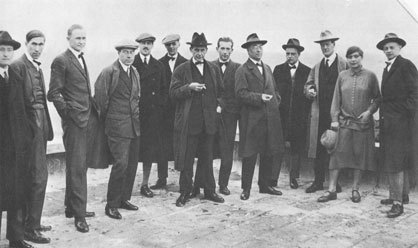
'Bauhausmeister' on the roof of the Bauhaus in Dessau in 1926 on the occasion of its opening on 5 December 1926.
×On the occasion of the 90th anniversary of the foundation of the Bauhaus and 20 years after the fall of the Berlin wall, the leading Bauhaus research institutions and museums in Germany – the Bauhaus Archive Berlin, the Stiftung Bauhaus Dessau and the Klassik Stiftung Weimar – are for the first time jointly presenting an exhibition. With about 1,000 objects it will be the largest Bauhaus exhibition ever. The Museum of Modern Art, New York, cooperating partner in the project, sent 25 objects to Berlin and will present its own exhibition “bauhaus 1919 – 1933. Workshops for Modernity” beginning on 8 November in New York.
Walter Gropius, working model for the 'Märzgefallenendenkmal' (Memorial for fallen revolutionaries), 1921. Classics Foundation Weimar © VG Bild-Kunst, Bonn 2009
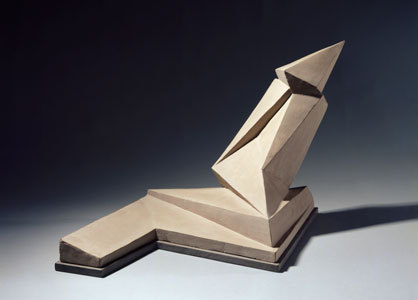
Walter Gropius, working model for the 'Märzgefallenendenkmal' (Memorial for fallen revolutionaries), 1921. Classics Foundation Weimar © VG Bild-Kunst, Bonn 2009
×The title of the exhibition shows the motivation of the Bauhaus to set a model for design. Throughout its existence – albeit with changing emphases - under the guidance of its three directors Walter Gropius (1919-1928), Hannes Meyer (1928-1930) and Ludwig Mies van der Rohe (1930-1933), the Bauhaus assumed the role of setting an example for the creation of design: not only in regard to the new type of school, but also as the avant-garde in developing contemporary art and architecture, as a laboratory for the development of models for industry and, last but not least, as a force of change in society, with its interest in giving modern mankind and his environment a new form.
Heinrich Siegfried Bormann, design for the Kandem tubular steel table lamp No. 934, 1932. Bauhaus Archive Berlin. Photo: Hartwig Klappert, Berlin
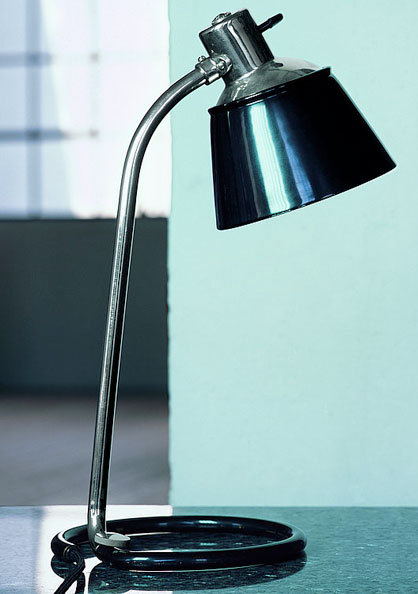
Heinrich Siegfried Bormann, design for the Kandem tubular steel table lamp No. 934, 1932. Bauhaus Archive Berlin. Photo: Hartwig Klappert, Berlin
דBauhaus. A Conceptual Model” impressively demonstrates the role that the relevant artistic positions - Expressionism, Futurism, Dadaism, Neue Sachlichkeit, Constructivism, and Surrealism - played at the Bauhaus between 1910 and 1933, as shown by the works of Marcks, Muche, Kandinsky, Moholy-Nagy, Albers, Bayer, Breuer, Schlemmer, Feininger, Klee, Meyer, Hilberseimer and Mies van der Rohe. The exhibition presents not only the Bauhaus Masters’ works but also those of their students. The latter illustrate the artistic development of the school and give an impression of the powerful impact of the Bauhaus, especially after its closure. Many Bauhaus students themselves later became influential artists of their generation, such as Wilhelm Wagenfeld, Max Bill, Richard Paulick, Marianne Brandt, Lux Feininger and many more.
Lyonel Feininger, Viadukt, 1920. Oil on canvas 100.9 x 85.7 cm. Museum of Modern Art, New York © VG Bild-Kunst, Bonn 2009
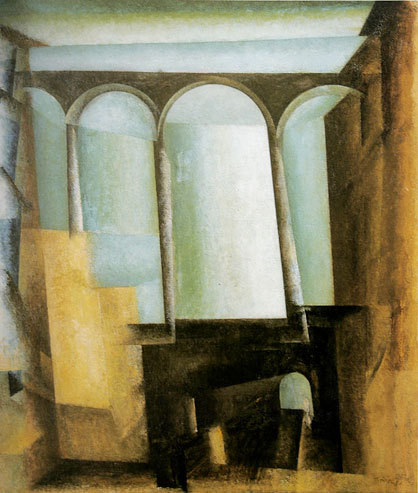
Lyonel Feininger, Viadukt, 1920. Oil on canvas 100.9 x 85.7 cm. Museum of Modern Art, New York © VG Bild-Kunst, Bonn 2009
×In order to convey the turbulent history and multifarious creativity of the Bauhaus, the exhibition “Bauhaus. A Conceptual Model” chooses the perspective of the history of its development. Thus it differentiates itself from the presentations to date, which were primarily oriented around the workshops of the Bauhaus.
Alfred Arndt, colour plans for the exterior design of the Bauhaus 'Meister' semi-detached houses in Dessau, 1926. Bauhaus Archive Berlin | BHA 976 © VG Bild-Kunst, Bonn 2009
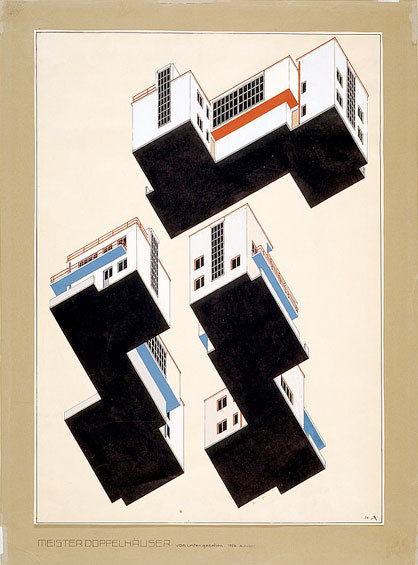
Alfred Arndt, colour plans for the exterior design of the Bauhaus 'Meister' semi-detached houses in Dessau, 1926. Bauhaus Archive Berlin | BHA 976 © VG Bild-Kunst, Bonn 2009
×Ittens’ Colour Sphere for Orientation
The visitor enters the exhibition through a gate in the historic foyer of the Martin Gropius Bau. The geometrical basic shapes – triangle, square and circle – take on a new function as the gates for the entrance, passageway and exit of the exhibition. The cliché of black and white Modernism that greets the visitor is the opposite of the purposefully colourful design of the exhibition in the historical Gropius Bau. In reference to Johannes Itten’s colour sphere, the exhibition architects chezweitz&roseapple delegated a colour to each of the Bauhaus’ stages of development.
Marcel Breuer / Gunta Stölzl, "African chair" ("Afrikanischer Stuhl"), 1921. Bauhaus Archive Berlin. Photo: Hartwig Klappert, Berlin
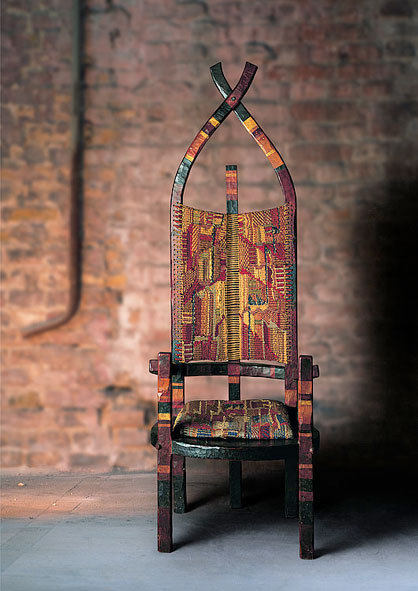
Marcel Breuer / Gunta Stölzl, "African chair" ("Afrikanischer Stuhl"), 1921. Bauhaus Archive Berlin. Photo: Hartwig Klappert, Berlin
×Do-It-Yourself Bauhaus (DIY Bauhaus)
The installation by Christine Hill “DIY Bauhaus – build your own Bauhaus!” is a contemporary artistic commentary on a legend. Christine Hill examines how the legendary Bauhaus has taken its place in today’s everyday life and living culture. The guiding idea for Christine Hill was the Bauhaus premise that the task of art and design is incomplete if it does not include the political-social dimension. Thus, her starting point is Hannes Meyer’s maxim, “People’s necessities, not luxuries”. Parallel to the commercialisation of Bauhaus objects as luxury items, Bauhaus ideas became trivialised. This is where Christine Hill, who became well known with her “Volksboutiquen” (People’s Boutiques) in 1995, begins her installation.
Marcel Breuer (design and realisation) / Gerd Oschmann (reconstruction) "Ladies' dressing table" ("Toilettentisch der Dame") from the Bauhaus experimental workshop "Am Horn", 1923 / 2004. Bauhaus Foundation Dessau. Photo: Hartwig Klappert, Berlin

Marcel Breuer (design and realisation) / Gerd Oschmann (reconstruction) "Ladies' dressing table" ("Toilettentisch der Dame") from the Bauhaus experimental workshop "Am Horn", 1923 / 2004. Bauhaus Foundation Dessau. Photo: Hartwig Klappert, Berlin
×Ilka & Andreas Ruby, Endless Bauhaus, video installation, 2009
In their video installation, “Endless Bauhaus”, Ilka & Andreas Ruby interview eleven contemporary figures on the relevance of the Bauhaus today. Is the Bauhaus an entity of the past, or is it significant today? What is left of its original intentions, and which of its ambitions could be carried on today? Which Bauhaus ideas seem to be impossible to fulfil today? Is there anything that we genuinely owe to the Bauhaus? Has the general Bauhaus challenge, the longing for the unity of the creative powers of art, crafts, technology and science, become anachronistic today – or do we need this kind of goal more than ever in the face of an increasingly specialised society? In order to find the answers to these questions, Ilka & Andreas Ruby met with various figures from diverse areas of design that are related to the Bauhaus in some way – architects, artists, curators, communication designers, automobile designers, art historians and entrepreneurs. The comments of the interviewees are thematically grouped and mounted into a virtual conversation.
László Moholy-Nagy, Light-space-modulator ("Licht-Raum-Modulator"), 1922-1933 (1970 replica based on the original in the Busch-Reisinger Museum (Cambridge/Mass.) Photo: Hartwig Klappert, Berlin. Bauhaus Archive Berlin © VG Bild-Kunst, Bonn 2009
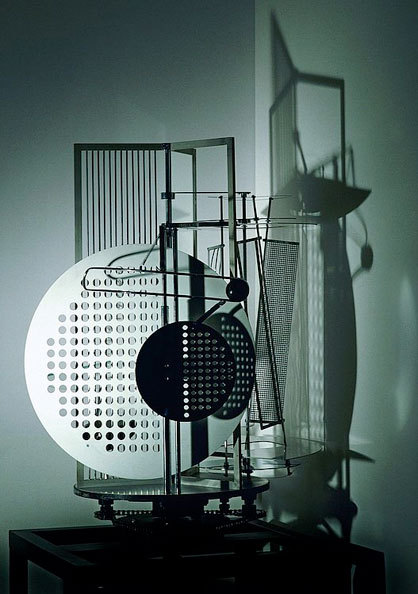
László Moholy-Nagy, Light-space-modulator ("Licht-Raum-Modulator"), 1922-1933 (1970 replica based on the original in the Busch-Reisinger Museum (Cambridge/Mass.) Photo: Hartwig Klappert, Berlin. Bauhaus Archive Berlin © VG Bild-Kunst, Bonn 2009
×A diverse programme of events will be offered to accompany “Bauhaus. A Conceptual Model”. It includes a five-day international conference “bauhaus global” (21 – 26 September 2009) supported by the Stiftung Lotto/ Stiftung Deutsche Klassenlotterie Berlin, as well as a lecture series, cinema nights, workshops, architecture tours and book presentations
Ludwig Mies van der Rohe, "Honeycom" (’Wabe’) submitted for the 'Hochhaus am Bahnhof Friedrichstrasse' competition for the design of a high-rise building at the Friedrichstraße railway station, 1922. Bauhaus Archive Berlin | BHA 8238 © VG Bild-Kunst, Bonn
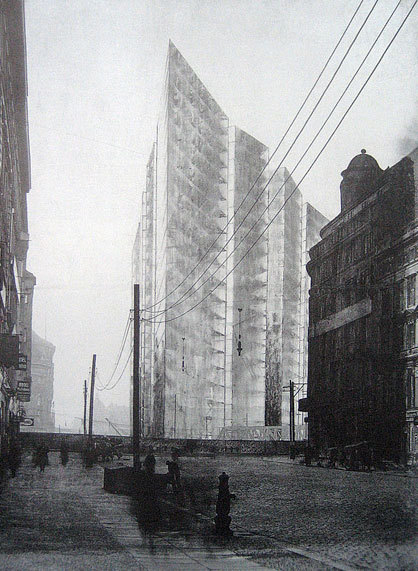
Ludwig Mies van der Rohe, "Honeycom" (’Wabe’) submitted for the 'Hochhaus am Bahnhof Friedrichstrasse' competition for the design of a high-rise building at the Friedrichstraße railway station, 1922. Bauhaus Archive Berlin | BHA 8238 © VG Bild-Kunst, Bonn
×Catalogue of the Exhibition and Audio Book published by Hatje Cantz
Wassily Kandinsky, "Without title" ("Ohne Titel") (for the folder presented to Walter Gropius on 18.5.1924), 1924. Bauhaus Archive Berlin © VG Bild-Kunst, Bonn 2009
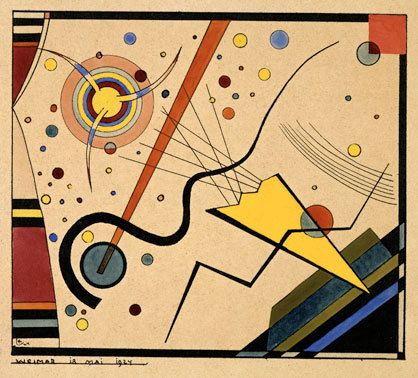
Wassily Kandinsky, "Without title" ("Ohne Titel") (for the folder presented to Walter Gropius on 18.5.1924), 1924. Bauhaus Archive Berlin © VG Bild-Kunst, Bonn 2009
×








